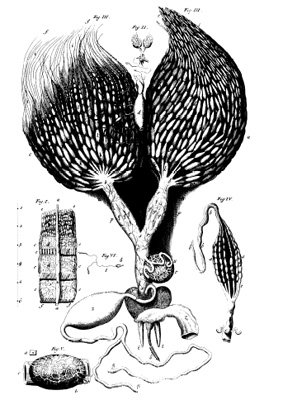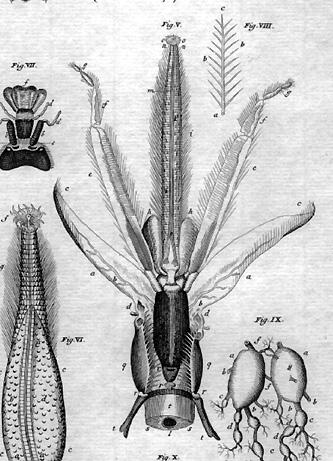 |
|
|
| Swammerdam’s science His life and work Nerve function Muscles Bees and ants "The Bible of Nature" Amazing drawings Techniques and microscopy Preformationism Swammerdam’s life Birth Death A fake “portrait” Science in society Empiricism and religion Mysticism and modern science Illustrations and their meaning Swammerdam in culture Swammerdam's world Friends and contemporaries Contemporary accounts On-line resources Under construction: Discussions of Swammerdam’s work A bibliography of Swammerdam's works Contact |
Swammerdam’s work on bees was begun in 1673 and completed in 1676-80. It contains around 57,000 words and includes 60 figures. It was finally published as part of “The Book of Nature” Dissections The most striking features of Swammerdam’s work are his drawings of his dissections. One of his most famous figures was his illustration of the queen’s ovaries. This extraordinarily detailed drawing, accompanied by three pages of description and a 1000-word long legend, was backed up by an attempt to count the number of eggs present in the ovary — he calculated that there were around 5,100 eggs in the ovaries.  “The Book of Nature”, Table XIX. The full original legend for this Table is around 1000 words long. The left hand ovary is that of an immature queen, the right-hand ovary of a mature queen. Swammerdam equally made the first precise descriptions of the bees’ mouthparts and of the sting and poison gland. In both respects his description was correct and highly detailed.  He also dissected the bee brain, showing the optic nerves projecting from the two compound eyes and the three ocelli.  Reproductive roles Swammerdam’s key breakthrough was to rightly describe the egg-laying function of the queen, and the anatomical differences between queen, worker and male larvae and nymphs. Swammerdam described in great detail the anatomy and development of larvae and nymphs, including the feeding of royal jelly to queen larvae and the anatomy and mechanics of larval moulting. He also observed the clustering of worker bees around the queen, in particular during swarming, but also in the nest. To demonstrate that some kind of “strong scent” was involved, he removed the queen on a stick and observed the workers flying to her, even if she was placed some distance from the hive. A mistake Swammerdam made a major mistakes when he stated that bees do not copulate, and that “the male Bees eject their sperm in the same manner as Fishes, who only shed it upon the spawn”. To justify this argument he pointed to the different shapes of male and female genitalia and the smell produced by drones, which he put down to the “rank and strong odour” of their sperm, which could thus act at a distance. This was a rare example of Swammerdam using rhetoric rather than experimentation to arrive at a conclusion. Reaumur (1740) described Swammerdam’s view as “very strange” and upbraided him for “thinking like the Ancients” rather than like a Modern on this question. However, Swammerdam did show that he was fully part of the new science: he suggested that it would be possible to test his hypothesis experimentally by seeing “whether the female Bee, enclosed in a little net made of fine thread, or in a small glass vessel covered with a piece of fine linen, or in a box with holes in it, could be impregnated by the bare scent of the male.” Experimentation Swammerdam carried out a series of experiments to show that the pain caused by bee, ant, hornet and wasp stings comes from the poison gland, and not from the sting. He demonstrated the sucking action of the mouthparts by cutting a hornet in half between the thorax and the abdomen (don't try this at home). He then fed the insect sugar water and showed that the liquid oozed out of the cut end of the thorax. He also studied the tracheal system, which he stretched out by inserting a human hair. Being a 17th century scientist, he used himself as an instrument, eating larvae both raw (“very disagreeable”, tasting of “rusty bacon”) and boiled (“they have a somewhat more agreeable taste; but if one continues chewing them, the former taste prevails again.”) To study social behaviour, Swammerdam had to observe the colony directly. While this was relatively easy in the case of domesticated bees, his study of ant behaviour meant he had to create what were apparently the first artificial nests: “I provided a large deep earthen vessel, and about six inches from the brim or verge of it, I put a bank or artificial rim of wax, and then on the outside of the circumference of this I poured water, in order to prevent the Ants confined in this enclosure from getting out. I afterwards filled the cavity of this dish with earth, and therein placed my little republic of Ants. It happened that in a few days the Ants laid their eggs in this vessel”. He also attempted to rear larvae himself, but found that “without the assistance of the working Ants, [...] I never succeeded”. Intrigued by the way the workers cared for the brood, he moistened the soil and observed the way the colony responded by carrying larvae and pupae; he also reported field observations of ants carrying brood outside the colony, apparently to be warmed by the sun. Colony structure Swammerdam provided a precise description of five bee hives and queens in different situations. In each case, he counted the number of bees and brood present. His largest hive, which swarmed during his observations, contained 6468 worker larvae and pupae, 2433 workers in the swarm and 8494 workers in the original hive. He also counted the number of queens as nymphs and ready to eclose, as well as the number of different kinds of cells. Having noted that all the social insect colonies were mainly made up of sterile females, with occasional production of males and the presence of one or more reproductive females, depending on the species, Swammerdam tried to explain why this kind of social organisation should exist. His views on this question changed with time: in his early study of ants, his description of the colony was marked by his mystical leanings: “there is no superiority or pre-eminence among either Bees or Ants; love and unanimity, more powerful than punishment or death itself, preside there, and all live together in the same manner as the primitive christians anciently did, who were connected by fraternal love, and had all things in common.” In his later study on bees, Swammerdam’s explanation of sociality was richer. Firstly, he noted that there was a clear reproductive division of labour within the colony: “the common Bees have no ovary, and therefore, like women who have lived virgins till they are past child-bearing, serve only the purpose of labour in the oeconomy of the whole body. These are thus by nature rendered incapable of doing any other business but that of nourishing and educating the young offspring”. Then he provided an explanation as to the function and driving force of sociality: “the cohabitation of Bees has no other end but to perpetuate their species; and thus, by the help of an exact order of production, to perpetuate their continuance.” The focus of this “order of production”, he argued, was the brood: “the actions of Bees of the three kinds, male, female, and eunuchs, spring from no other cause but from a vehement and ardent concern, by which they are carried to the generation, preservation, and raising of the brood, which, as it is alone the principle, so likewise it is the end of every thing the Bees do.” Swammerdam not only considered that reproduction was the factor that held the colony together, he also suggested that it was involved in causing conflicts: “As therefore it is generation alone by which the Bees are excited to all their actions, so this great cause, whenever it happens to be interrupted, is the sole motive from whence all the confusion at times observed in the hives arises”. The kinds of “interruption” he described included queen sterility, or the presence of two queens in the hive, which gives rise to physical battles between the two individuals. He emphasised the importance of there being only one queen per hive, although he also noted that this is not the case in all social insects, and also noted an apparent relation between polygyny and reproductive ability: “This [polygyny] is manifest in Hornets and Wasps; for these insects suffer many females at once in the nest. It is proper to observe here this remarkable difference, that each of these females lay only a few eggs”. The fact that Swammerdam focused on reproduction was as much a consequence of contemporary fascination with this great mystery as a result of his close observation of insect behaviour. (This page is adapted from an article that appeared in Insectes Sociaux Vol 49, pp 92-97, 2002. © Birkhäuser Verlag, 2002). To download a PDF version of this article, click here. |